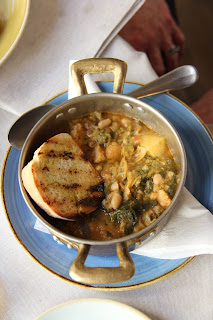Today we crammed in two small villages that had tales to tell. The first was Monteriggioni, purpose-built by Sienna as a bastion on a hilltop during its long and never-ending battles with Florence.
They built it sound. They built it strong. It was completely encircled by walls with just one gate to the north, facing Florence, and one to the south, facing Sienna. It had fourteen massive strong towers overlooking the valley on all sides.
There were even garden plots built inside the walls, and fountains to water them, so that in times of siege the hill community could be self-sufficient, if needed.
It seemed impregnable. And it was. Battle after battle Florence made no headway against Sienna's clever bulwark.
Until, one dastardly night on the 29 August 1554, the commander of the garrison, Captain Giovanni Zeti, secretly rode out and negotiated a deal with the Florentine forces besieging the town: his own skin and the good graces of Cosimo 1 of Florence, if he cooperated with them.
He then gave the keys of Monteriggioni to the Florentine troops. And thanks to that betrayal they were able to easily enter the garrison, take the community as slaves -- and finally, Monteriggioni was defeated.
It is said that on dark and gloomy nights Zeti's ghost, unable to live with his betrayal, wanders underground passages in the community, moaning still.
Tourists come by bus loads. Walkers still follow the pilgrim route through Monteriggioni, heading to Rome.
One local artist even sculpted a drinking fountain tablet on the edge of town that looks for all the world like a medieval font: carving signa pellegrinorum in stone, inspired by the small devotional emblems made of lead and uncovered on the route from long ago pilgrims who wore them stitched to their clothing as emblems. Signs that they had made it this far. The way that today's tourists display stickers on cars, denoting their travel stops.
It looks much as it ever did. With medieval fountains in the square, and boutiques selling products that are modern, but that could easily be medieval.
We then drove south through this once contested area. Today it is a peaceful country, with cyprus drives leading to Chianti castellos, their fields of grapes separated by row crops of fava beans, that enrich the rocky soil with nitrogen.
We stopped for a delicious lunch in a pretty fortress town of Castellina in Chianti, which had another tale to tell of the constant battles between Sienna and Florence for supremacy in the area.
Tired of warring over the region, it is said that the Florence and Sienna authorities agreed to a plan for boundaries. At the crow of a cock each would send a knight -- one leaving from Sienna and heading north, one from Florence, heading south-- so that where they met enroute would be the dividing line and become the agreed boundary limit for each territory.
Sienna selected their cock ready for the dawn wake up. A white cock, fat and fine. They fed him well, put him to roost, and went to bed.
Florence selected theirs. A black cock with a swirly tail. They starved him, keeping him hungry all through the night.
Clever Florence.
The black cock woke first. Hungry. He crowed so early that the Florentine knight set out well in advance of the knight from Sienna. Both made good ground but when they met here in Castellini in Chianti, the Florentine knight had covered more territory, giving his state much larger gains than the Siennese.
Even today, the black rooster is the symbol of Chianti Classico wine famous throughout the world. And the tale draws tourists to the pretty town with its fortress, La Rocca, standing tall and strong. And its alleys low and long. Tales live long in these hills and valleys.
 |
| Monteriggioni inspired Dante's Inferno |
 |
| Monteriggioni, a powerful bastion for Sienna |
 |
| In times of siege was self-sufficient |
 |
| Impregnable construction |
 |
| Zeti gave the keys of Monteeriggioni to the Florentines |
 |
| Zeti's ghost is said to wander here, moaning aloud |
 |
| Monteriggioni is on the pilgrim route to Rome |
 |
| A modern sculpture that looks like a medieval monument to the pilgrims |
 |
| Boutiques selling modern products that could be medieval |
 |
| Cyprus drives leading to Chianti castellos |
 |
| The hills of Chianti |
 |
| The black rooster is today the symbol of Chianti Classico wine |
 |
| La Rocca, in the fortress town of Castellina in Chianti |
 |
| Alleys in Castellina in Chianti are low and long |




















































